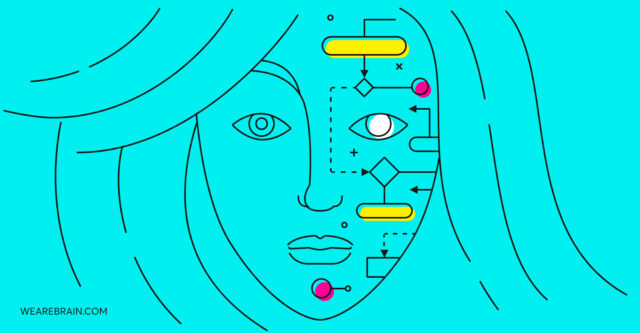
AI-powered technologies are changing the nature of work, for better and for worse. Yes, smart machines and automation technologies are being leveraged across global industries to drive greater efficiency and output at a fraction of the financial cost of human labour.
However, despite the vast benefits these technological disruptions provide, they also come at a worryingly greater cost to the global workforce of tomorrow: algorithm-centric business approaches potentially exacerbating economic inequality.
The ‘code ceiling’
According to a brilliant Harvard Business Review article penned by futurist and author Mike Walsh, AI-powered organisations have a ‘code ceiling’ that prevents upward mobility and career advancement due to the fact that most of the incoming workforce — especially freelance and junior positions — rarely interact with human coworkers but instead are managed by algorithms.
With little possibility of moving up in the job market, the result is those lucky enough to secure a job are forced to occupy the same position throughout their time in the workforce, effectively killing aspirations for personal growth through advancements in career, salary, and skills. This leads to a model of fit-for-purpose labour that essentially creates a workforce of lids designed only to fit very specific pots.
The concept of working from the bottom to rise up through the ranks of a traditional organisation is set to become a relic of a bygone era. The ‘code ceiling’ of AI-powered businesses prevents this aspirational trope to continue as humans are increasingly being managed by algorithms aimed at increasing efficiency and profit. These come in the form of time and location tracking and assessment monitoring.
With daily tasks being managed by an algorithmic feedback loop, it not only makes asking for a raise or getting permission for a bathroom break more cumbersome for workers, but it also creates systemic inequality due to the hierarchy of information flow.
Amazon is gaining a reputation for getting machines to crack the whip on human factory workers. According to widespread reports, Amazon has used AI to track hundreds of fulfilment centre employees and fire them for failing to meet productivity quotas. “Amazon’s system tracks the rates of each individual associate’s productivity and automatically generates any warnings or terminations regarding quality or productivity without input from supervisors” according to the report.
In machine management working environments, like most factories and ride-hailing businesses, for example, company leaders only need to share information with employees that help them perform their duties. There is no requirement to inform workers of holistic business approaches and strategies. This reduces the ability for workers to gain upward mobility within an organisation as they are only fed information pertaining to their specific tasks.
The digital divide
The data shows that the gap between employees who are highly educated and skilled and those who are not is widening. In Walsh’s recent book The Algorithmic Leader: How To Be Smart When Machines Are Smarter Than You (2019), he explores a potential future scenario where there is a ‘class-based divide between the masses who work for algorithms, a privileged professional class who have the skills and capabilities to design and train algorithmic systems, and a small, ultra-wealthy aristocracy, who own the algorithmic platforms that run the world’.
This dire scenario shows what a future of the gig economy run on algorithms might look like. The feedback loop of job leads transmitted and managed by smart devices locks workers into an echo chamber that, once inside, is very difficult to escape. Thus, a global workforce of employees tied into performing specific tasks at a specific wage will be controlled by a small group of employers which leaves little to no room for upward mobility and economic equality.
Another well-known futurist and author, Martin Ford, suggests that this scenario of automation taking over and eradicating human jobs is already on track to becoming a reality in the next 10-15 years. Recent research indicates that by 2030, at least 14% of employees globally could need to change their careers due to digitisation, robotics, and AI advancements. He states that when you break it down, the greatest asset humans have to live a comfortable life is the value of their labour. However, the rapid pace of our global technological advancements threatens to devalue our labour as machines run on algorithms are able to perform many of these repetitive tasks, at a fraction of the cost. With our global population increasing each year, matched with the rate of our technological advancements, the future value of human labour is in jeopardy.
Although automation is predominantly designed to assist humans with repetitive, rules-based tasks, the continuous evolution of machine learning capabilities is now beginning to threaten not only blue-collar but also white-collar jobs. Ford states that “what we see now is that this technology is much broader, it’s beginning to displace cognitive capability or even intellectual capability”. This is set to dramatically alter the working landscape of tomorrow as these sectors comprise the majority of the global workforce.
Current displacement reality of tomorrow
The impact of algorithmic management is accelerating rapidly. AI has eliminated 77,999 jobs in 2025 across 342 tech company layoffs, with entry-level jobs being especially at risk, affecting nearly 50 million positions globally. Research shows that workers aged 18–24 are 129% more likely than those over 65 to worry AI will make their job obsolete.
The displacement patterns reveal stark inequalities. 49% of Gen Z job seekers believe AI has reduced the value of their college education, whilst 40% of white-collar job seekers in 2024 failed to secure interviews. Meanwhile, high-paying positions (£96K+) have hit decade-low hiring levels.
MIT research shows AI will replace 2 million manufacturing workers by 2025, but finance jobs might disappear even faster because everything is data-based. IBM’s AskHR handles 11.5 million interactions annually with minimal human oversight, demonstrating how algorithmic systems are replacing entire categories of human work.
The emergence gap
The displacement isn’t matched by equivalent job creation in accessible roles. Whilst 170 million new roles will emerge by 2030, there’s a critical skills gap: 77% of AI jobs require master’s degrees, and 18% require doctoral degrees. This creates a fundamental mismatch between who loses jobs and who can access new opportunities.
350,000 new AI-related positions are emerging, including roles such as prompt engineers, human-AI collaboration specialists, and AI ethics officers. However, the educational requirements effectively exclude many of those displaced by automation. The people who are likely to be displaced by algorithms in the coming years, predominantly white- and blue-collar employees, are not going to be able to necessarily take up the new positions that technology will introduce into society.
41% of employers worldwide intend to reduce their workforce in the next five years due to AI automation, yet the replacement jobs require entirely different skill sets and educational backgrounds. This disparity creates a structural unemployment problem that extends beyond temporary displacement.
Geographic and demographic disparities
The impact of AI displacement varies significantly across demographics and regions. Analysis shows that 58.87 million women in the US workforce occupy positions highly exposed to AI automation compared to 48.62 million men, highlighting significant gender disparities in vulnerability to algorithmic displacement.
Regional variations show North America leading automation adoption at 70% by 2025, whilst economic impacts include substantial cost savings for businesses through AI implementation. However, these savings rarely translate into wage increases or retraining opportunities for affected workers.
How to prevent algorithm inequality of tomorrow
Sure, technological advancements will displace many jobs but will also create new ones. However, what it displaces it cannot replace entirely: far from it, in fact. Most new positions will involve creating or working closely with the technology used to displace many workers, so the affected workers cannot realistically be expected to easily adopt these new positions because if they could, they wouldn’t be displaced in the first place. A disparity will arise, the evil twin of inequality.
But it is not all doom and gloom. Knowing that the future will consist of machines automating predictable, repetitive, and routine jobs previously occupied by humans, society will need to anticipate this and leverage human qualities that cannot be automated…yet.
Recent data shows that project management and UX design are among the most recommended upskilling paths for workers in 2025. Lifelong learning and upskilling are now a top priority for 75% of employers, indicating recognition of the need for workforce adaptation.
We are now given the exciting opportunity to leverage our creativity, critical thinking, and problem-solving skills to create a future society that rewards human-centricity. With mundane tasks operating off of algorithms, it frees us up to tap into our collective imagination and create a job landscape that rewards and embraces creativity to be used as a tool to shape our future.
The key insight from current research is that rather than focusing solely on traditional career paths, workers should look for roles that bridge domains — positions that combine human judgement with AI capabilities, or that translate between technical systems and business needs. The share of jobs in STEM fields grew from 6.5% in 2010 to nearly 10% in 2024, an almost 50% increase, suggesting that technical skills remain valuable.
However, the transition requires coordinated effort. Successful navigation of this algorithmic transformation requires immediate upskilling initiatives, human-AI collaboration strategies, and coordinated public-private workforce development programmes to mitigate negative impacts while capitalising on emerging opportunities.tool to shape our future.
